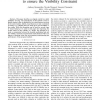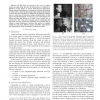37 search results - page 4 / 8 » Analysis of classical and new visual servoing control laws |
IROS
2006
IEEE
13 years 11 months ago
2006
IEEE
— This paper describes an original control law called qualitative servoing. The particularity of this method is that no specific desired value is specified for the visual featu...
ICRA
2009
IEEE
13 years 12 months ago
2009
IEEE
Abstract— This paper presents a new model-free visual servoing that is able to servo a robotized 2D ultrasound probe that interacts with a soft tissue object. It makes direct use...
ICRA
2009
IEEE
13 years 12 months ago
2009
IEEE
— In this work we propose a new way to achieve visual servoing using directly the information (as defined by Shannon) of the image. A metric derived from information theory, mut...
ICRA
2000
IEEE
13 years 9 months ago
2000
IEEE
We propose in this paper new redundancy-based solutions to avoid robot joint limits of a manipulator. We use a control scheme based on the task function approach. We first recall...
IROS
2006
IEEE
13 years 11 months ago
2006
IEEE
– Robotic systems like humanoid frequently move to undesirable pose while being visually controlled at the boundary of its workspace, because the working environment is quite hug...


